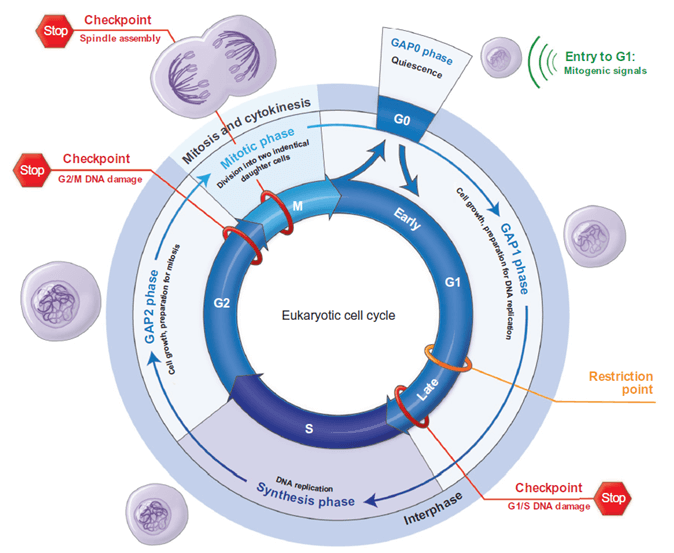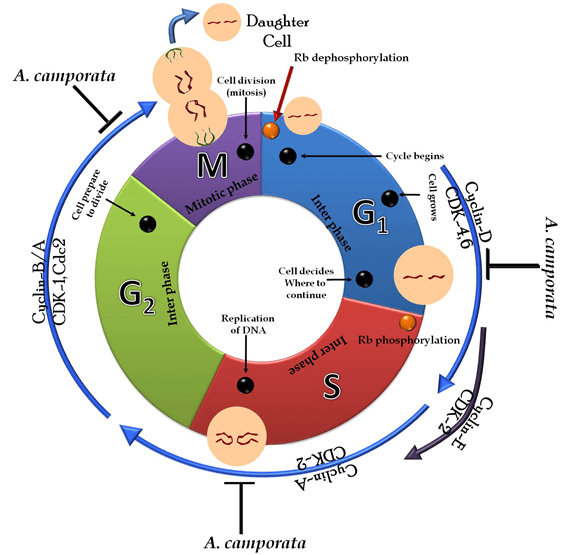Creative Bioarray provides high-quality cell cycle assays and professional results analysis services relying on our advanced technique platform and experienced scientific team.
Introduction of Cell Cycle
Cell cycle, also known as cell-division cycle, refers to the series of sequential events that cells divide themselves from one cell into two identical daughter cells. Each daughter cell will begin a new cell cycle after division. Standard cell cycle of eukaryotic cells can be divided into the interphase (G1, S and G2 phase), the mitotic phase (M phase) and G0 phase (resting).
The interphase, including cell growth, nutrients accumulation and DNA replication, is the preparation for cell division. It is indispensible for making the next mitosis possible. In the mitotic phase, the genetic materials replicate and equally separate into two daughter cells. Cell cycle checkpoints are responsible for the control of proper cell division. Growth factors and receptors, signal transducers and transcription factors also play an important role in stimulating cell division.
 Figure 1. The cell cycle: different phases and major events. (Ferry, I. et al., 2018)
Figure 1. The cell cycle: different phases and major events. (Ferry, I. et al., 2018)
Importance of Cell Cycle
Cell cycle is the main process leading to cell proliferation. It is crucial for the growth, development, regeneration, healing and survival of organisms. Abnormal cell cycle is involved in the pathogenesis of various major diseases, such as cancer and autoimmune disorders. Most cancers are the result of aberrations in normal cell cycle regulation. Therefore, analysis of cell cycle is of great significance to cell biology, molecular biology, oncology and pharmacology. Modulators of cell cycle can be used as potential therapeutic tools.
 Figure 2. Schematic diagram of A. camphorata-induced cell cycle arrest in various cancer cells. (Yang H L, et al., 2012)
Figure 2. Schematic diagram of A. camphorata-induced cell cycle arrest in various cancer cells. (Yang H L, et al., 2012)
Cell Cycle Assays Available at Creative Bioarray
Each stage of cell cycle has its specialized biochemical processes and characteristic events, cell cycle assays and analysis can be used to separate cell populations in different phases of cell cycle. Our cell cycle assays include but not limited to following:
Flow cytometry
Flow cytometry is the most common method for cell cycle assessment and a powerful tool for accurate analysis. DNA in living or fixed cells can be labeled with fluorescent dyes, such as PI, 7-AAD, Hoechst 33342, and DAPI. The amount of fluorescent signal is proportional to the amount of DNA. This method allows discrimination between G1, S, G2 and M phases of cell cycle.
BrdU Incorporation Assay
BrdU, an analog of thymidine, can readily incorporate into the synthesized DNA of actively dividing cells. Cell cycle can be accurately monitored by BrdU incorporation assay.
Fluorescence Ubiquitination-Based Cell Cycle Indicator System
Fluorescence Ubiquitination-Based Cell Cycle Indicator (FUCCI) is a two-color indicator which can be used to label cells and follow cell division within a cell population. It can realize real-time observation in living cells.
Creative Bioarray can customize the best cell cycle solution according to different cell types, sample types and research purposes. Our professional scientists can help analyze the experimental data. Reagents for cell cycle detection are also available at Creative Bioarray. We can meet all your needs related to cell cycle.
If you are interested in our services or products, please feel free to contact us. We look forward to cooperating with you.
References:
- Ferry, I. et al. Targeting Cell Cycle Proteins in Brain Cancer. Handbook of Brain Tumor Chemotherapy, Molecular Therapeutics, and Immunotherapy, 2018, pp: 271-290.
- Yang H L, et al. Multiple molecular targets of Antrodia camphorata: a suitable candidate for breast cancer chemoprevention. Targeting New Pathways and Cell Death in Breast Cancer, 2012, pp: 157-179.
- Zhivotovsky B, & Orrenius S. Cell cycle and cell death in disease: past, present and future. Journal of internal medicine, 2010, 268(5), pp: 395-409.
- Otto T, & Sicinski P. Cell cycle proteins as promising targets in cancer therapy. Nature Reviews Cancer, 2017, 17(2), pp: 93-115.
For research use only. Not for any other purpose.

 Figure 1. The cell cycle: different phases and major events. (Ferry, I. et al., 2018)
Figure 1. The cell cycle: different phases and major events. (Ferry, I. et al., 2018)
 Figure 2. Schematic diagram of A. camphorata-induced cell cycle arrest in various cancer cells. (Yang H L, et al., 2012)
Figure 2. Schematic diagram of A. camphorata-induced cell cycle arrest in various cancer cells. (Yang H L, et al., 2012)
